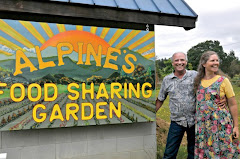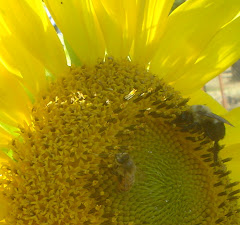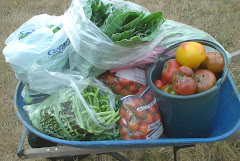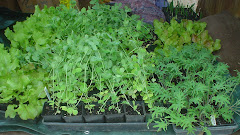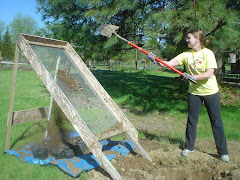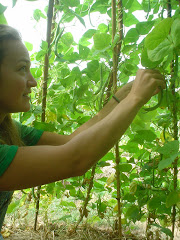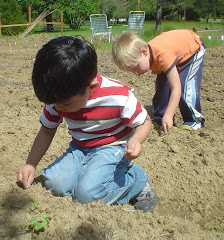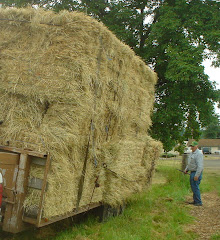 |
| Jim husks blue corn. |
Part of becoming more self-sufficient has been to grow our own
corn-meal. We chose an heirloom-variety of blue corn called Hooker's
Blue because it's easy to grow, has high yields and makes delicious corn-meal that can be used as hot cereal, and in baked goods such as corn
bread and pancake mix.
Our first corn crop was in the summer of 2015. We'd been given a small, shriveled ear at a seed-swap. The corn was already two years old and, since corn seed degrades faster than most, we weren't sure how viable it would be. In this case we pre-sprouted it and only planted seeds that germinated. Our young friend Serenity patiently and diligently planted the corn in cultivated soil -- 5" apart and 1" down, gently covering the seeds with soil as she went.
 |
| This is the cob-size we used to start our first crop of Hooker's Blue corn. Just two years later, our harvest is enough to feed us for a year with surplus to share with the garden-families who help us (at least 10-gallons of shucked corn! This was from four, sixty-foot rows.) |
We have a lot of blue-jays in our neighborhood, and some crows - both who
love corn! One year we planted corn, saw the new seedlings sprout above-ground in the afternoon -- a whole long, row of them, came back the next morning and discovered that
each and every one had been dug up and eaten! So, to prevent this happening again we covered our newly planted corn with 'floating row cover' (brand-name: "Reemay") a synthetic, white cloth that lets rain and sunlight reach the plants but protects them from light frosts and hungry garden-creatures! Reemay must be pinned in place, or held down with bricks or stones. It can be left on till seedlings start pushing at it from below at which point it's unlikely that birds/animals will dig up and eat your plants.
 |
| Covered
row cloth protects young crops from mild frosts and animals that might
eat the tender, new plants. Remove once plants are pushing up on bottom
of cloth. (Pic credit) |
The soil we planted in was fairly poor and newly tilled so once the seedlings were a few inches above-ground, we gave them a thorough soaking with compost-tea.
 |
| Compost tea is steeped in large batches and then poured generously on crops to fertilize them. |
That first year, our harvest was moderate but plenty for a large seed-crop to plant in our second year. Since we had plenty of fresh seed, we used a different method for planting. We prepared the ground by spreading a light sprinkling of wood-ash
LINK. Chris tilled this into the soil as deep as the tiller would go. He then scattered a combination of corn seed and kidney bean seeds (a 'bush' variety that we dried and shelled for use in soups and chili). He then set the tiller to a very shallow setting - about 2", and tilled both varieties of seed into the ground. We then marked the row with string so no-one would walk on it and waited for the seedlings to emerge.
 |
| The orange string (around bed to left of hose) is used to mark newly planted soil so no one walks on it by accident. |
Corn is typically a heavy-feeder (it needs rich, fertile soil). If your soil is depleted, your corn-crop will benefit from additional feeding as it grows. This past year, about mid-season, after a thorough weeding, we added a thick layer of partially composted leaves and grass-clippings around the base of the corn and bean plants. Then, whenever we watered, the plants were fed.
 |
| Shucking corn and shelling beans are a favorite autumn activity at the Sharing Gardens. |
Corn is pollinated primarily by wind so it is best if you plant either multiple rows, near to each other, or wide-beds (the width of the tiller - as we did). If you are growing a small crop, planting it in a solid square, or block works well too. Since the beans and corn are both left till dry on the plant, you do not need access to the plants in the center of the patch during the growing season. (Note: Hooker's Blue corn is also quite tasty as a sweet-corn if you harvest it once kernels are fully formed but still soft and yellow. Cook as you would regular sweet-corn).
 |
| Hooker's Blue corn, though not very tall at full height (typically 4 to 4 and 1/2 feet) yields large harvests -- one to two 4"-6" ears per stalk. Here, students are mulching an adjacent bed with wheat straw. |
 |
| In this picture, corn has finished ripening, and partially drying on the stalk. Christie harvests the ears to be husked and further dried in our greenhouse. |
Because we use the corn to make corn-meal, we leave it on the plants, in the field, till it is quite hard and has turned dark purple (almost black). We check it every few days by pressing a fingernail into the kernels of corn. It's done when you can no longer dent it with your nail. Ears of corn are then harvested, husked and left to dry on racks in our greenhouses. The dryer it is, the easier it is to remove the kernels from the cob (shucking). If Fall weather starts getting too damp for the corn to dry properly, we bring it inside and put it on shelves above our wood stove to finish the process.
 |
| Christie and Chelsea remove husks and lay cobs onto a drying table to continue to dry. Corn is easiest to remove from the cobs if it is dried well. |
Shucking can be done simply by twisting the cobs in your hands to break loose the kernels (you might want to wear gloves!). If you have a lot of shucking to do, here's a simple tool Chris made that really speeds up the process!
 |
| Home-made corn-shucker. The cob is twisted against protruding screws. |
 |
| Close-up of corn-shucker. Long screws are driven in from four sides leaving an interior hole ~ one-inch in diameter so cob fits but corn is rubbed off; wood is added at ends to prevent splitting and the handle makes it easier to use. |
 |
| A tub of dried corn-kernels. |
Lastly, be sure to store your corn in a cool place, in air-tight containers. Because of corn's high oil content it can go rancid; this ruins the flavor and makes it unhealthy to eat. Be sure to set aside enough seed for next year's crop. To ensure best viability, we
freeze our corn-seed in air-tight containers.
Grinding corn: Obviously, if you're growing your own corn for grinding, you're going to need a grain-mill! After carefully comparing reviews of different brands and models, we chose to invest in a top-of-the line
Diamant grain-mill. This is considered an 'heirloom' appliance in that, with proper care it will last for generations. Ours came with a handle for hand-grinding, can be hooked up to a bicycle for larger, human-powered batches or hooked up to a small motor (which is what we did) so we can grind large batches with ease. If the price-tag is prohibitive, consider purchasing one with your neighbors and setting it up in a central location for all to share.
 |
| Mill hooked up to motor for faster grinding. It comes with a handle, for hand-grinding and we also have seen instructions for hooking it up to a stationary bicycle. |
 |
| Close-up view of Diamant grain-mill. The 'can' on top has an open bottom and allows us to pour more grain in at a time. The knob at left adjusts the fineness of the grind. |
|
 |
| Close-up of mounted engine. |
Variety we like: Hooker's Blue corn
Obtained from Native Americans in the Pacific NW (Washington state, USA) in the 1950's. It is an Heirloom, non-hybrid variety that will "grow-true" year-after-year so you can save your own seed.
Description: 75-80 days - to maturity. The 4-4 1/2 foot stalks produce 5-7 inch ears of
some of the finest tasting corn. Ears typically have 10-12 rows of
kernels that dry blue-black upon maturing - 1 or 2 ears per plant
LINK - Reviews of Growers.
Why we like it: Does well in a cooler, damper climate. Because of its short-stalk, it won't 'lodge' (fall over) as taller varieties sometimes do. Grinds into the sweetest
cornmeal! Can be as much as 30% higher in protein than regular 'sweet-corn'
LINK-nutritional facts.
Favorite recipes: Hooker's Blue corn is deliciously sweet and nutty-flavored. Here are some ideas for using it in recipes.
Hot cereal: Stir ground corn into lightly salted water in a 2:1 ratio (twice as much water as corn). Gently heat the corn and water together, stirring occasionally and simmer on low heat, in a covered pan for ~20 min.
Crumb-Free Whole Grain Corn Bread: We make a large batch of the dry-mix ahead of time so it's easy to just add milk, eggs and oil for a quick batch of corn bread or pancakes. Yum!
LINK-Recipe
Whole Grain No-Knead Bread: We've adapted Jim Lahey's delicious no-knead bread-recipe to incorporate whole wheat flour and blue-corn meal. So tasty and nourishing!
LINK-Recipe
Scarlet Runner Beans: Here is a post about
"Growing Your Own Protein - Scarlet Runner Beans" - LINK. Beans and corn together give you all the essential amino-acids needed in one meal (a complete protein) and it's delicious too!
 |
| Beautiful scarlet runner bean blossoms! |
Leave us your tips for growing, and links to recipes in the comments below!





















































